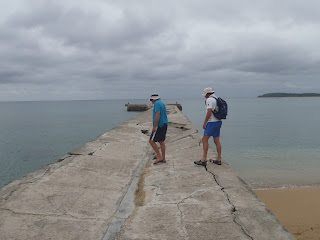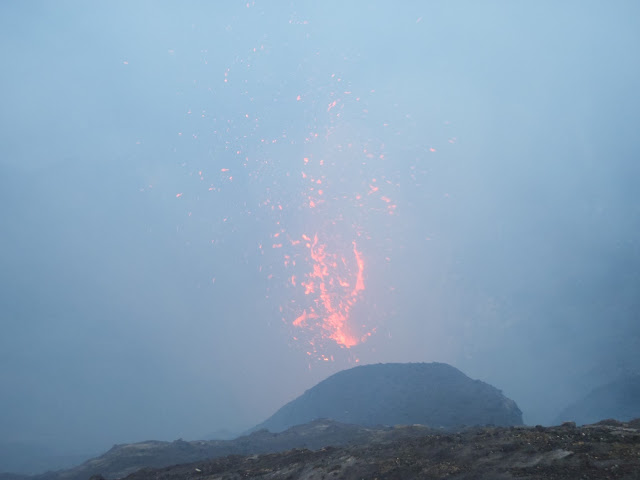Sunday 19th July Ambae and Maewo Islands
An end to the light winds is forecast on Tuesday so we decided
to make the most of the light conditions and head East over to Ambae and Maewo
Islands. We could then run back to Luganville later next week in the stronger
ESE Trades that were forecast. This proved to be a good move with a fantastic
50 mile windward leg with full main and No.3 on relatively flat water to the
eastern tip of Ambae, where we shared the spectacular anchorage at Loloru Bay
with one of the Island trading boats.
Monday 20th July
Our intention was to go ashore here at Loloru Bay and but a
sleepless night for the skipper due to a stomach upset plus a noisy anchor
chain dragging over the rocky bottom convinced us to leave early to beat the strong headwinds forecast for
today. It’s only a short 10 mile hop to the little village of Asanvari at the
Southern end of Maewo and we motored across in a couple of hours which gave the
refrigeration a big boost for the day.
This little village of 170 people boasted a “yacht Club” built with Aus Aid but little remains of the
building. I suspect it was ratted by the locals for the timber for use in their
own houses. This has been a popular stop for cruising yachts in the past but we
were only the 20th to visit since the cyclone, according to Alex,
the custodian of the little waterfall that tumbles into the Bay. We haven’t
seen another yacht since leaving Santo and even then there would have only seen
about 20 other boats at any one time in the Santo area.
Our guide for today was Nisha, an 11 year old girl who is
the niece of the chief. There is a little primary school here with 3 teachers
for the 97 students, (once again children under 12 outnumber the adults by 50%)
but her teacher had gone away for the day so she was free to roam. We met chief
Richard who gave us permission to roam at will. Under nishas guidance we
wandered the village and ended up at Alex’s waterfall complex for a swim.
He is a remarkable guy who used to be a radio announcer in
Port Vila but decided to leave the rat race and moved here to be with his
brother leaving his wife and sons behind in Port Vila as they didn’t want to
move.
Alex has reclaimed the bush on the foreshore where the
little creek runs onto the beach and built a small hut and level area where he
can entertain (and charge) visiting yachties. All up through the waterfall area
he has planted many exotic plants and lives on site all alone waiting for the
boats to come in. Sometimes it’s a long wait between boats!
However he turned out to be an excellent guide as he walked
us through some of the highland villages above the anchorage. This part of
southern Maewo is very isolated with no airstrip or roads connecting it to the
rest of the island.
The early people here wiped each other out due to inter
village rivalries and the area was unpopulated for a long time until a group of
familys from Northern Pentacost resettled the area in the 1940’s Today they
live a very subsistence lifestyle and have little contact with the outside
world. Any medical emergency involves a long boat ride to either Pentacost or
Loloru on Ambae. Another family we met was Erica and her husband who are
building a 3 room guest house (with a hammer and bush knife as tools!)so they
can cater for visitors. I admire the effort they are putting in but suspect
there won’t be many visitors wanting to do the long ride to the village in a
long boat!
We dropped off the last of the Coles Bay baby clothes to
Olivette, the local nurse/midwife who looks after the 450 people living in this
village and the surrounding hill people.
As with most of the islands we have seen the jungle on this
island is covered in a very fast growing creeper which apparently was
airdropped as seeds by the Americans during the Second World war to hide their
installations from the Japanese. This makes many areas impenetrable and the gardens
hard to keep clear.
Wednesday 22nd July
We had heard of Loltong Bay at North Pentecost Island and as
it was only about 10 miles further south across the 3 mile wide passage between
the two islands we decided to take the opportunity to check this area out.
The village anchorage is behind an extensive reef with a
narrow passage marked by a set of leads. We anchored in a sandy patch in about
4 metres of water close to the main beach. This is a very busy little village
and once ashore we were greeted by Mathew, the brother of the chief. Mathew and
his wife Mary have built a “yacht club” and restaurant catering to visiting
yachts. Once again very few yachts have visited since the cyclone and they were
keen to cook a local meal for us, which we agreed to. This turned out to be a 9
course meal, and covered most of their root vegetables and local fruits with a
tuna salad the main feature. Quite tasty.
We were delighted to hear the village drums start up just
before dark and went ashore to watch the spectacle. All of the drums are
hollowed out logs of various sizes played by the men and boys of the village.
There had been a death in the village recently and the drums sound out just
before dark and early after dawn as a mark of respect.
This village has a huge nackemal which is the “men’s club”
where they get together late in the day to make and drink their kava (a local
drink made from the roots of the kava plant that makes the drinker verrrry
relaxed!) and to discuss the business of the village. Every village in Vanuatu
has its nackemal and it is the centre of village life.
We also spent some time with Mary in her garden and touring
the village which is on the foreshore at the base of some very steep terrain
with only one very rough 4wd track out
As our 30 day visitor’s visa is due for renewal on the 26th
we had to cut our visit short after one night and make the 50 mile sail back to
Luganville on Thursday to catch the immigration office on Friday 24th. We
picked up a mooring at Aore Resort again and renewed our acquaintance with Anne
and her very friendly staff. Apparently Friday is International Children’s Day
and it’s a public holiday so we won’t be talking to immigration until Monday!



















































